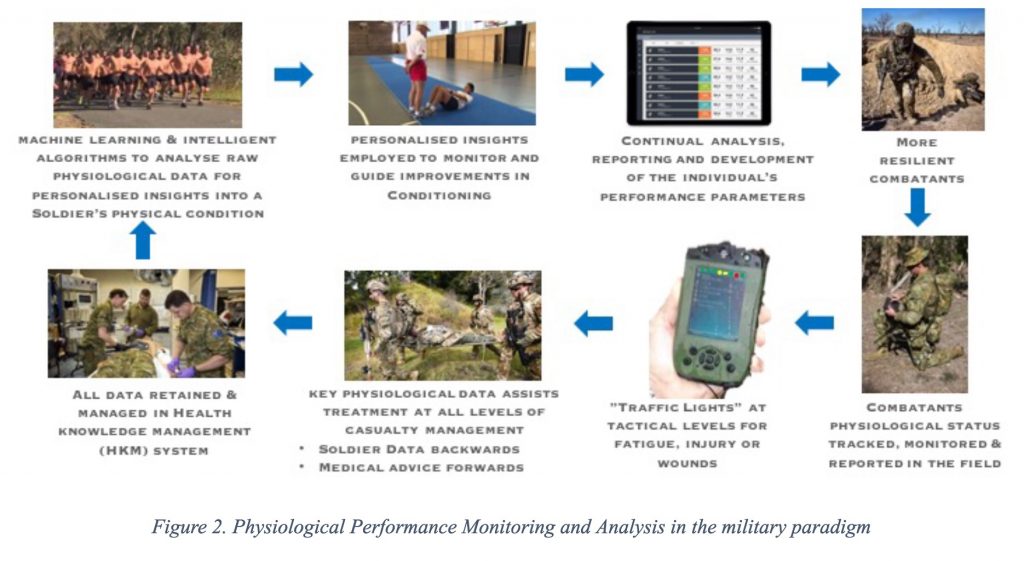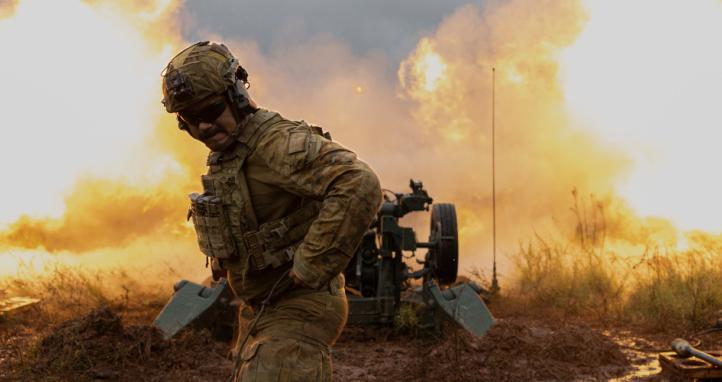Synopsis
Improving the resilience of individuals is a key goal of every organisation in which physical and psychological performance is paramount to the achievement of organisational goals. The ability to adapt, recover and improve while enduring adversity enables the organisation to thrive.
Within the military sphere, the capacity of individuals, teams and organisations to adapt and thrive in situations of risk, challenge, danger, complexity and adversity [1] enables the organisation to prevail. It can be the difference between victory and defeat [2].
Physiological data collection is an important tool that hereto has been unavailable in a deployable model. Whilst it can have an enormous effect on the development of the physical condition of the combatant, the benefits of its integration and use in the operational context go much broader, and will have a significant effect in almost all contexts relating to the individual in the Operational Lifecycle [3] (Figure 1).
Sport
The use of modern data collection systems has been instrumental in changing the face of sport worldwide. Tracking 'metres gained', speed, acceleration and impact enables sports teams to analyse and continually improve the performance of the individual and hence the team, with a view to achieving victory in the short, medium and long term, whilst also guarding against injury. Remembering that injuries affect not only the individual but also the team's performance.
The Australian National Rugby League (NRL) instituted player trackers in May 2017 using special radio frequency identification devices (RFID), in combination with a number of receivers placed around the stadiums. This was paralleled in the Australian Football League (AFL) at the same time, to record and display player metrics related to speed, acceleration and distance covered. The prime example of this type of system is the SPT GPS® system which is used by over 1,000 sporting teams worldwide. [4]
Military Application in Conditioning
The devices used to track speed and acceleration in the sporting world have limited application in the development of physical conditioning for the military. Notwithstanding that the sporting applications focus on physical metrics rather than physiological data, their lack of integration into the military communications network severely limits their utility.
The collection of physiological data does however have significant application. For non-operational use this can be effected through the use of standalone devices coupled with applications on tablet computers. For field use, integration into headsets or hearing protection may complete the coverage of users.
The ability to derive data for such individual variables as core body temperature (CBT), heart rate (HR), heart rate variability (HRV), oxygen uptake (VO2), blood pressure (BP) and respiration rate, combined with speed and distance, can be an enormous tool. Collected accurately, and in real time, its application to the development and maintenance of physical conditioning is ground breaking.
Prepare
Physical conditioning, in the form of physical training, can be monitored and analysed from the moment the individual enters the organisation. Using machine learning and intelligent algorithms to analyse raw data, personal insights into a combatant's physical condition can be developed within all aspects of training. Personalised insights can then be employed to guide improvements in conditioning. Combined with targeted nutrition analysis (and modification), as well as cognitive analysis, physiological performance analysis complements the operational cycle.

Augment
Beyond conditioning and into the operational theatre, continual analysis, reporting and development of the holistic picture of the individual's performance parameters can be used to monitor performance in combat. Commanders at all levels can be continually cognisant as to the physical condition of the individual and team, understanding when they reach (or exceed), the physiological performance of which they are capable. Being able to foresee and monitor when an individual is approaching their known performance parameters enables commanders at all levels to modify the tempo of the battle; exceeding the parameters if necessary to achieve an immediate goal, or retaining a reserve of performance for when the situation evolves.
In a prolonged assault, knowing that the respiration rate of individuals is peaking, but that CBT is within norms, may tell the commander that the force can continue but will require some recovery time.
Knowing that the CBT of armoured vehicle crew members is exceeding safe norms, enables commanders to take immediate steps to modify the individuals' environment and direct medical attention if required.
When in contact with the enemy, a sudden drop in BP and variation or cessation of respiration rate may be an indicator that an individual has been severely wounded but is unable to communicate. Reported audibly and/or visually as cues (depending on the situation), commanders can then respond quickly and appropriately.

Provided as data managed in the force Battle Management System (BMS), this information can also be relayed to higher commanders for situational awareness of force resilience and capacity. The data can also be conveyed along the lines of communication to the force evacuation and medical support personnel, enabling assessment and monitoring of the casualty through the evacuation chain. Specialist advice can be pushed forward to the lead commander to assist in treatment, and to the evacuation teams to enable focused care.
Reset
Once in the medical system the physiological data garnered from the individual's previous physical condition, the circumstances surrounding the injury/wound, and data collected since the event, can be used in effective treatment; with all of the data stored within the Health Knowledge Management (HKM) system. Data analysis and intelligent algorithms can also be used to aid in the physical recovery of the individual, with a view to re-entry into the force.
Summary
The above is not science fiction. The capabilities detailed are available now via the use of in-ear physiological data collection devices, coupled with machine learning and intelligent algorithms to analyse the raw data. In the UK, a system was developed in response to the death by hyperthermia on a training course of UK Special Forces personnel in 2013. The technology was designed for use by military personnel, first responders, athletes and sports people.
The concept of operation for these devices continues to evolve as more is learnt about what the data can reveal. Its integration into the management of human performance in organisations is the next step in the evolution of development of individual, team and force resilience.





Stick to catapult or statsports gps trackers which are more accurate